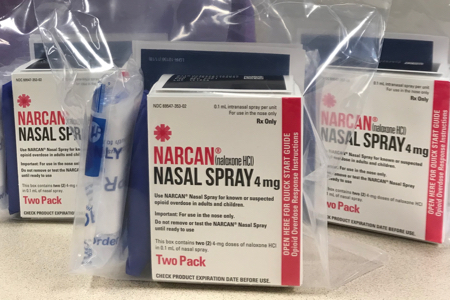Be Prepared for an Opioid Overdose
An overdose occurs when the body cannot handle the amount of opioids in the system. This causes someone’s breathing and heartrate to slow down or even stop.
Naloxone is a life-saving medication that can reverse the effects of an opioid overdose. Naloxone works by binding to the same receptors in the brain that opioids attach to, specifically the mu-opioid receptors. Opioids, such as heroin or prescription painkillers, activate these receptors, which can slow or stop breathing, leading to overdose. Naloxone acts as an opioid antagonist, meaning it blocks these receptors, reversing the life-threatening effects of the overdose.
By displacing opioids from the receptors, naloxone can quickly restore normal breathing, often within minutes. However, its effects are temporary, so it’s important to seek emergency medical help right after administering naloxone, as the effects of opioids may outlast those of naloxone.
Naloxone is specifically designed to reverse opioid overdoses, so it does not work on overdoses caused by other types of drugs, such as:
- Stimulants: Naloxone does not reverse overdoses from substances like cocaine, methamphetamine, or ecstasy.
- Benzodiazepines: Drugs like Xanax, Valium, or Ativan, which are often prescribed for anxiety or sleep disorders, are not affected by naloxone.
- Alcohol: Naloxone does not counteract alcohol poisoning.
- Other non-opioid drugs: Naloxone also does not work for overdoses from substances such as barbiturates, nicotine, or marijuana.
While naloxone may not work on these drugs, it’s still SAFE to administer if you suspect an overdose, as it won’t harm someone who isn’t experiencing an opioid overdose. However, for non-opioid overdoses, emergency medical help should be called immediately.
Click here to Request Free Narcan Kits (and other additional resources)

Information and Resources
How to get NARCAN® in Lancaster County:
- You can get NARCAN® at most pharmacies with or without a prescription from your doctor. In Pennsylvania, there is a public standing order. This order allows pharmacies to give NARCAN® to anyone. It is covered by most insurances.
- If you do not have insurance or cannot pay your copay, we can help!
- NARCAN® is available while supplies last. Submit your request here.
Risk Factors for Overdose
- Anyone who uses prescription or non-prescription opioids can be at risk for overdose. An overdose can happen when someone:
- Takes a prescription opioid in a way that is not prescribed
- Uses a non-prescription opioid (like heroin)
- Uses an opioid or other drug that is contaminated with a stronger opioid, such as fentanyl or carfentanil
- Takes opioids with other medications (like benzodiazepines or sleeping medication), alcohol, or illegal drugs
- People at a higher risk for overdose include those who:
- Use prescription opioids with a high dose, with additional prescriptions, or with a history of substance use disorder or overdose
- People who use non-prescription opioids, especially if they are injected
- People who have already had a non-fatal overdose
- People who previously used opioids but currently have a reduced tolerance (for example: after detoxification, incarceration, or treatment)
- People over the age of 65
- People with certain medical conditions, such as sleep apnea or reduced kidney or liver function
How to Prevent an Overdose
- You can prevent an overdose by:
- Following tips for safe prescription use, storage, and disposal
- Seeking help with opioid misuse, opioid use disorder, or other substance use disorders
- If using non-prescription opioids, it’s best to never use alone, ask someone to check on you, use one drug at a time, use less after any period of decreased use, test the strength of the drug or use less at first, and make an overdose plan
- Know the signs of an overdose and how to use NARCAN®
Signs & Symptoms of Opioid Overdose
- Some of the signs and symptoms of an opioid overdose are:
- Unresponsiveness or unconsciousness (the person will not wake up or respond to voice or touch)
- Pupils in the center of the eye are very small, pinpoint-sized
- Breathing is slow, shallow, stopped, or sounds like choking or gurgling
- Pale, clammy, cold skin
- Lips and fingernails turn bluish purple (for lighter skin tones) or grayish, ashen (for darker skin tones
- For more information, watch this informational video
How to Respond to an Opioid Overdose
- What to do if you suspect an overdose:
- Call 911 right away. The 911 operator may give instructions.
- If you have NARCAN® or another form of naloxone, use it. Follow the instructions on the packaging (note: naloxone will not hurt someone if opioids are not in their system)
- You can give additional doses of NARCAN® every 2 to 3 minutes.
- Do CPR to the level of your training.
- Do not leave the person alone. Stay with them until emergency medical help arrives.
- Encourage the person to go to the hospital to receive emergency medical care after an overdose.
- Instructions in English and Spanish here
- For more information about NARCAN® and training videos, visit
